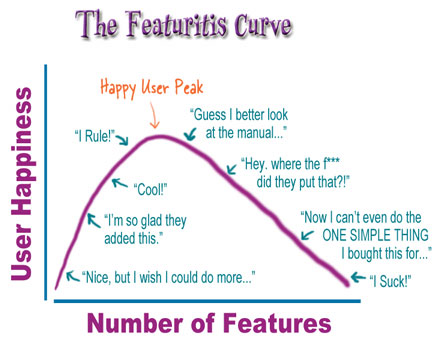Software business has matured a lot in the past decade and feature wars are passe. We are amused when some payroll software vendors still resort to feature lists to compare and sell software.
Customers buy software to solve their problems. Features are initially added in response to a genuine need but it is very easy to get distracted and infected by creeping featuritis. Here's a nice illustration that sums up the problem from one of our favourite blogs: Creating Passionate Users.

We hope our team doesn't get infected by this malady as they toil daily to make our online HR and payroll software the best one money can buy.
Our current focus is how to improve the reporting in Greytip Online and provide business intelligence for our users. A dilemma we face is whether to provide a longer list of reports (and risk increasing the clutter) or give a smaller set of reports with report options that can be tweaked to generate a wide array of reports (and risk increasing complexity).
For example, consider this Payment Transfer reports. You can easily create a dozen reports called "Bank Transfer Statement", "Cash Transfer Statement", Cheque Transfer Statement", etc. Here's what we do instead:
So we have one entry in the Reports List called "Other Payroll Transfer Statement" which launches a dialog box. You could easily pollute the report list by showing 4 separate entries for each of the payment types. But this is where you need to exercise good judgement.
Our earlier version had the Bank Transfer Statement as just one more payment type. But the user interface was more complex and we decided to move out the Bank Transfer Statement as a separate report. Also, it makes sense because bank transfer is the most common payment type. So, there is no simple formula to blindly follow but you need to deal with design decisions with awareness.
While discerning users will focus on the essentials, many vendors try to sway customers with large feature lists and hundred of reports. This blog entry titled 'billions and billions of reports' hits the nail on the head.
Seriously, here's the thing. More reports is rarely the answer. We already have plenty of data and plenty of reports. What buyers and users really want is fewer reports and more information that helps them get their jobs done better and faster.









